
Strobilanthes - Strobilanthes: planting, growing and caring
Contents
Strobilanthes in a nutshell
- The genus Strobilanthes includes nearly 250 species of perennials and bushes.
- Some are hardy enough to be grown outdoors in France.
- Woodland plants, strobilanthes thrive in partial shade.
- These perennials prefer rich, moist, and well-drained soil.
The word from our expert
It is difficult to generalise about a genus as little-known as it is vast and diverse. That is why I will limit myself to discussing only the hardy strobilanthes.
Hardy strobilanthes, particularly Strobilanthes penstemonoides, are rarely offered for sale. A mistake! Because these perennials are low-maintenance, multiply easily, and thrive in normal, rather moist, well-drained soil. Add to this that the summer flowering, in a beautiful delicate blue, seems endless and continues until the frosts. Their slightly wild appearance brings a lot of natural charm to flower beds.
Thanks to their Himalayan origins, the cold and winter humidity of Belgium and northern France do not faze them in the slightest. They adapt very easily to all situations, provided it is not too dry (and the soil is not too chalky!), and they never fall ill.
In short, strobilanthes are perennials, or rather undershrubs, that deserve to be planted more widely. If you love woodland atmospheres and plants of Asian origin: Go for it! You won’t be disappointed.
Botany and description
Botanical data
- Latin name Strobilanthes sp.
- Family Acanthaceae
- Common name Strobilanthes, Strobilantes
- Flowering July to October depending on the species
- Height 30 cm to 150 cm
- Exposure sun, partial shade, shade
- Soil type rich and moist, but well-drained, without limestone
- Hardiness very hardy for ground-planted Strobilanthes
Strobilanthes belong to the Acanthaceae family. Native to Asia and Madagascar, the genus Strobilanthes includes nearly 250 species of perennials and undershrubs. Their natural habitat is on forest edges or in woodland undergrowth. The genus was first described by the botanist Carl Ludwig Blume in 1826.
Most are not hardy enough to survive our winters, such as Strobilanthes dyerianus, and are grown in pots or as annuals.
However, around thirty species are native to the Himalayan mountains and are hardy enough to thrive in our gardens year-round. These include, among others, Strobilanthes attenuata, Strobilanthes yunnanensis, Strobilanthes atropurpureus, Strobilanthes nutans, Strobilanthes walichii, or Strobilanthes penstemonoides (formerly rankanensis).
Strobilanthes are cultivated for their beautiful foliage, sometimes very colourful, and their summer flowering that extends into autumn, often in a striking blue hue. The hardy species are typically undershrubs forming bushes, sometimes up to a metre in all directions, as in the case of Strobilanthes penstemonoides.
The foliage is deciduous. The ovate leaves are opposite and finely dentate. They are green in colour, occasionally purple (Strobilanthes brunetthy) or violet-mauve (Strobilanthes dyerianus).
The stems are characteristic: they feature more or less swollen nodes, from which new roots frequently emerge when they touch the ground, thus spreading the plant, which does not produce many seeds.
The inflorescence consists of large tubular flowers in shades of blue to blue-mauve, sometimes white, as in Strobilanthes nutans. The flowers are most often paired at the end of a slender stalk. Flowering begins in summer and continues for months, until the first frosts.
Note that the plant resumes growth very late in spring, during the month of May.

Some flowering species: Strobilanthes penstemonoides, Strobilanthes nutans, and Strobilanthes attenuata
Our favourite varieties
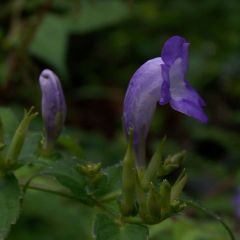
Strobilanthes attenuata
- Flowering time September to November
- Height at maturity 1,50 m
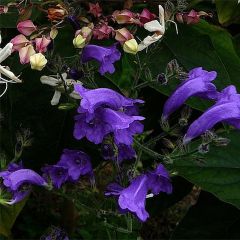
Strobilanthes attenuata Blue Carpet
- Flowering time September to November
- Height at maturity 80 cm
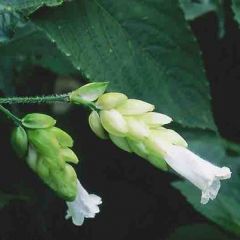
Strobilanthes nutans
- Flowering time August, September
- Height at maturity 30 cm

Strobilanthes penstemonoides
- Flowering time October, November
- Height at maturity 1 m
Discover other Strobilanthes
View all →Available in 1 sizes
Available in 1 sizes
Available in 1 sizes
Available in 1 sizes
Available in 1 sizes
Planting Strobilanthes
The genus Strobilanthes should be divided into two cultivation categories. The hardy ones, which can be grown in open ground, and the non-hardy ones, which should be grown in pots or containers during the warmer months.
Where to Plant?
Hardy Strobilanthes, such as Strobilanthes atropurpureus, Strobilanthes penstemonoides, Strobilanthes attenuata, or Strobilanthes nutans, should be planted in open ground in partial shade or full shade under tree cover. In northern regions, most species tolerate a sunnier location. These perennials thrive in fresh, well-drained soil, rich in humus and free from lime. However, once established, Strobilanthes can tolerate dry conditions.
For non-hardy Strobilanthes, such as Strobilanthes dyerianus, the container must be well-drained. Use a pot or planter with drainage holes at the bottom! Place a layer of clay pebbles or gravel at the base, then fill with a mix of one-third garden soil, one-third universal compost, and one-third compost. Position the pot away from direct sunlight and cold winds.
When to Plant?
Planting for species hardy enough to survive in the garden year-round should be done in spring once the soil has warmed sufficiently, from March to June, depending on your climate. Earlier in the South and Southwest, and around May-June in the North.
How to Plant?
- Loosen the soil well to a depth of about 20 centimetres;
- Moisten the root ball and remove it from the pot;
- Dig a hole roughly twice the size of the root ball;
- Strobilanthes require fertile, well-drained soil: don’t hesitate to mix some gravel or clay pebbles with the soil used to fill the hole. A good handful of compost will also be beneficial;
- Place the root ball in the centre of the hole;
- Backfill with the excavated soil (mixed with gravel if the soil is too compact) and lightly firm it around the collar with your fingers;
- Water thoroughly to eliminate any air pockets between the soil and the roots;
- Mulch well to reduce watering needs and keep the soil cool.
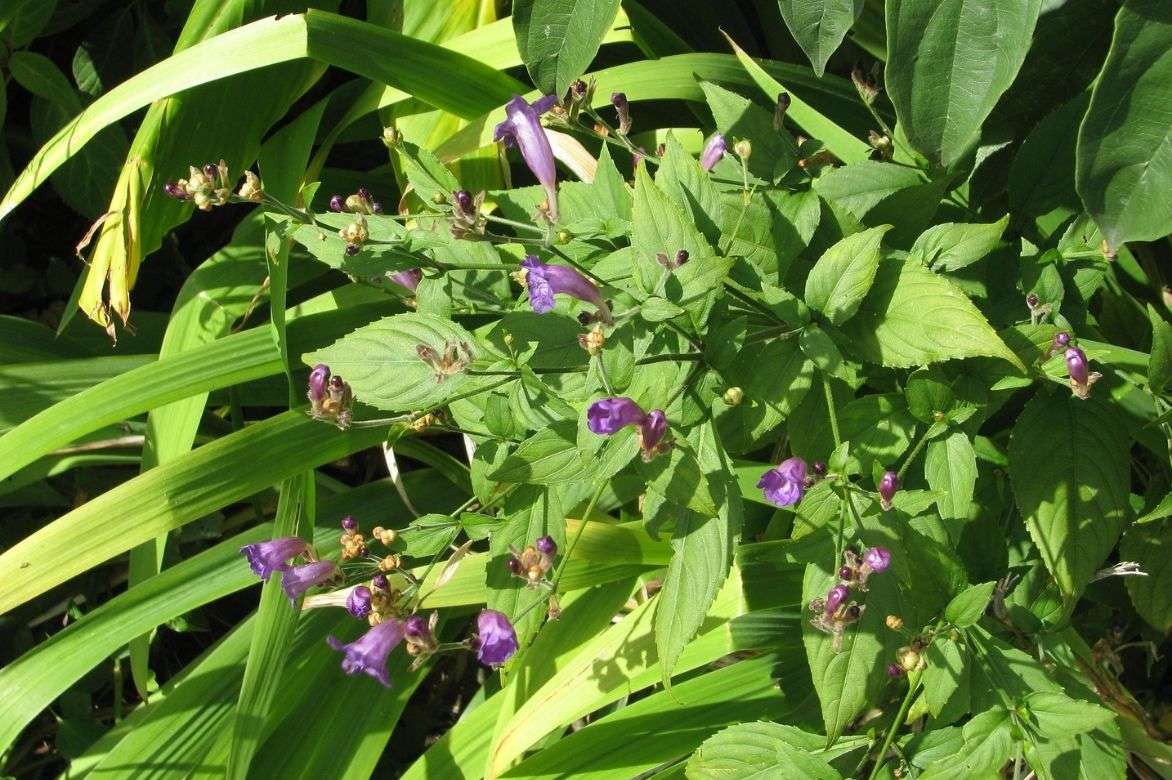
Strobilanthes penstemonoides (syn. rankanensis) – Photo Peganum (Flickr)
Maintenance
Growing strobilanthes is easy, and maintenance is very minimal.
In the ground
The plant alerts the gardener when it’s thirsty by drooping its foliage. If this happens, give it a good watering with non-calcareous water. A good mulch will help maintain sufficiently moist soil to prevent the plant from suffering. The mulch will also protect the stump from severe frost in winter.
You can pinch the terminal shoots in June (this will give you cuttings!), to encourage the plant to branch out. The clump will be shorter, the plant will produce more flowers, but they will appear later.
At the end of winter, cut back the dry stems before the growing season resumes: in March-April.
In pots
Place your Strobilanthes in a saucer filled with clay pebbles (or small gravel) kept moist. Mist the plant regularly to maintain good humidity. If needed, add a balanced liquid fertiliser, with a good phosphorus content.
If your Strobilanthes becomes bare at the base, you can prune it in April before the growing season resumes. A cut of about one-third of its height will be sufficient.
Diseases and Pests
Strobilanthes grown outdoors are rarely affected by diseases and pests.
Only Strobilanthes grown indoors may suffer from an attack of mealybugs. You can remove them using a single damp sponge or a cotton swab dipped in alcohol. Repeat this process as many times as necessary until the mealybugs disappear.
Multiplication
Seeds are available commercially, but sowing yields disappointing results. Propagation by cuttings, on the other hand, is far more effective!
Propagating a strobilanthes is, in fact, child’s play.
- Take terminal cuttings in summer, about 10 cm long, cutting just below a swollen node;
- Remove the lower leaves, keeping only the two leaves at the top;
- Place your cuttings in a bucket filled with a special sowing and propagation compost;
- Cover with a cloche or a plastic bottle cut in half: this is known as “propagation under cover”;
- Place your cuttings in a warm, bright spot, but out of direct sunlight;
- After 5 to 6 weeks, the cuttings should have rooted;
- Keep your young plants in buckets, then transplant them into a larger pot when the roots emerge from the drainage holes;
- For hardy species, transplant them into the ground the following spring.
Even simpler, if your strobilanthes thrives in your home, you can take advantage of the plant’s natural propagation ability. At the swollen nodes, there is what is called an “abscission point,” a natural breaking point. In short, if you shake the plant, pieces will detach at the nodes. These stem fragments will then fall to the ground and produce roots from the node. The plant essentially propagates itself.
Association
Hardy Strobilanthes are woodland plants that thrive in partial shade and well-drained, moist soil. They will therefore be a perfect addition to the garden alongside other plants that enjoy these growing conditions.
The Strobilanthes penstemonoides will be in good company with hostas, such as the Hosta ‘Blue Cadet’ with its lavender flowers, and barrenworts, like the Epimedium grandiflorum ‘Purple Pixie’ with its bright purple-pink flowering.
A few Rodgersia henrici will add vertical interest with their flower spikes reaching over a metre in height. The scene can be completed with meadow rues or thalictrums and, why not, a Kirengeshoma palmata, whose buttery-yellow flowering emerging from very graphic palmate foliage will perfectly complement the long flowering period of the Strobilanthes.
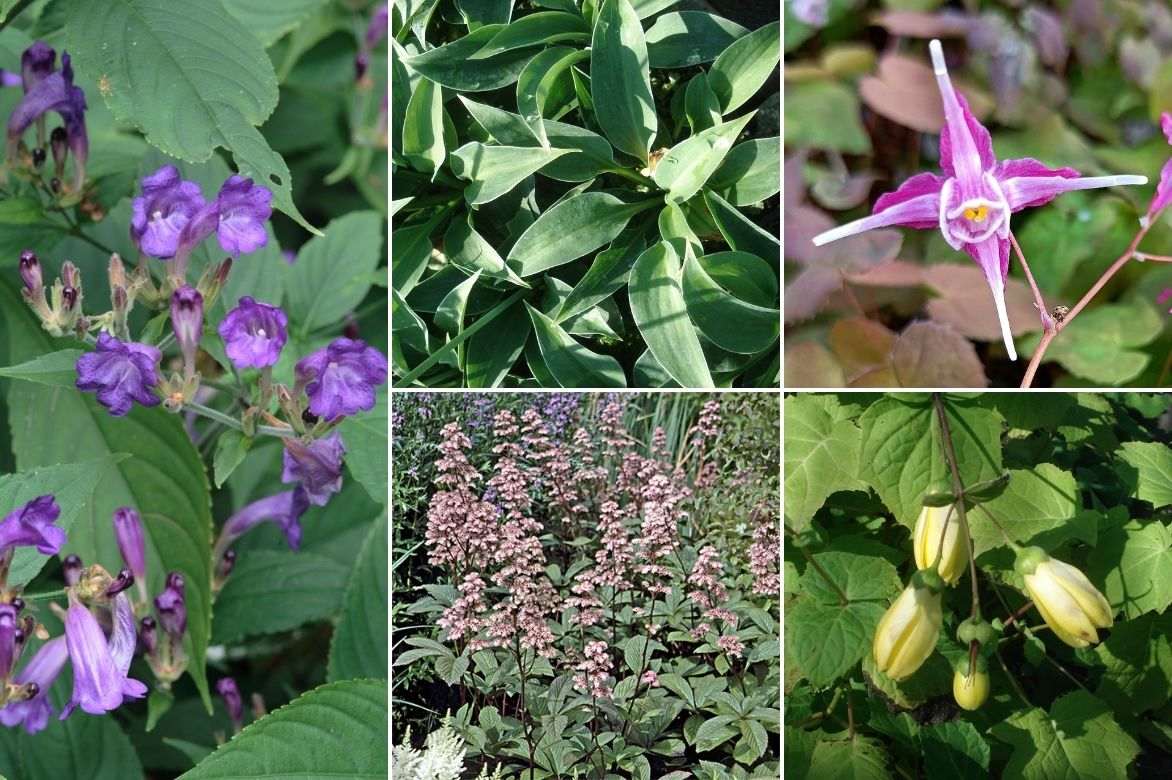
An association idea: Strobilanthes penstemonoides, Hosta ‘Blue Cadet’, Epimedium grandiflorum ‘Purple Pixie’, Rodgersia henrici, and Kirengeshoma palmata
Useful resources
→ Discover all our Strobilanthes in our online nursery.
- Subscribe!
- Contents
































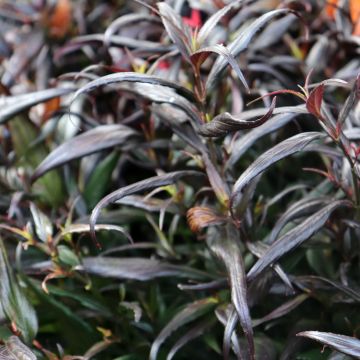



Comments